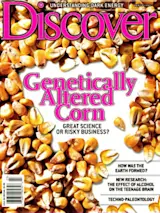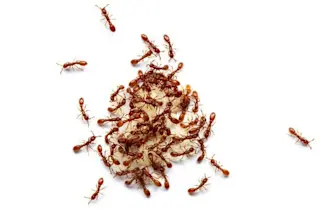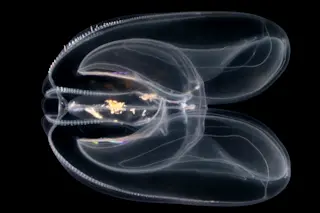Soon it will be planting time in Iowa, and Jim and Sharon Greif, farmers in the village of Prairiesburg, will be starting up the CornCam. Mounted on a pole near their house, the CornCam was a great success last year. Every 15 minutes it dispatched images of their field to the Internet. To the couple's surprise, they got more than 2 million hits, people logging on all summer just to watch their corn grow.
Occasionally the Greifs got e-mails asking if they raised genetically modified crops, a sensitive subject. The CornCam's sponsors, a seed company and a farm journal, advised the Greifs not to touch it. About 25 percent of the corn grown in the United States has been armed with a bacterial gene that produces an insecticide, making the plants poisonous to caterpillars. Most such corn is mixed with conventional corn, and most consumers are unaware of the difference. The Greifs grow genetically modified corn, but not a lot of it. Sharon Greif, therefore, was vague in answering the e-mail. "Greenpeace could come out and destroy your test plot, you know," she says.
Ironically, if Jim had oriented the CornCam a little to the right, Americans could have watched StarLink corn grow. StarLink is the corn that triggered last fall's recall of taco shells, tortillas, and many other corn-based foodstuffs from supermarkets. It is the one genetically modified corn not approved for human consumption. The costs of its recall— losses to farmers, to food companies like Kraft and ConAgra, to grain exporters like Archer Daniels Midland, and to the StarLink manufacturer, Aventis— are still being totaled, but they may exceed $1 billion. More important, the episode may have shifted the debate over genetically modified foods in the American diet— shifted opinion against them, according to one national poll.
StarLink corn was supposed to have been used only in animal feed. Since last September, when an environmental group discovered it in food for humans, StarLink has come under tremendous scrutiny. From the magnitude of the response— the cascading recalls and litigious finger-pointing— you might think the corn posed a grave health threat, proof that genetically modified foods were dangerous. Although more than 40 consumers claim to have suffered allergic reactions, a dozen of them worthy of medical attention, the cases are unclear and can't be confirmed. Experts and even some environmental opponents of genetically modified crops agree that the risk of StarLink to public health was low. Still, opponents have seized the opportunity to question the safety of our food supply because something that was not supposed to get in it did get in it. As for StarLink, it is finished. Yanked off the market, never to be planted again, the corn symbolizes the fear of genetically engineered foods in this country and around the world.
Jim Greif left most of his StarLink standing through the winter. The seven-foot brown stalks, each with a bulbous ear, rustled forlornly in the snow. "This'll go to hog feed, I guess," he said, puzzled by the controversy.
Starlink is a type of "Bt" corn. its foreign ingredient is taken from a common soil organism, Bacillus thuringiensis, whose insecticidal properties have been known for 100 years. The first commercial spray containing Bt was developed in Europe before World War II, and in 1961, the pesticide was registered for use in the United States. Biologist Rachel Carson was keen on Bt. In Silent Spring, her landmark book about the hazards of pesticide overuse, she listed it among the promising alternatives to DDT and other synthetic compounds.
Organic farmers embraced Bt because the natural product leaves no chemical residue. That is also Bt's drawback, because the spray breaks down rapidly in sunlight and washes off easily. Moreover, many pests are beyond its reach, such as those attacking the roots.
By 1980, scientists had isolated the crystalline proteins in Bt bacteria that are poisonous to bugs. There are dozens of such toxins that work against different families of insects, and most share the same general mechanism. Specifically, the Bt poisons bind to cells in the stomach lining and cause a kind of internal bleeding. Because the insect gut is alkaline, and the mammalian gut is acidic, Bt toxins don't do the same thing inside humans. The spray formulations are considered so innocuous that the Environmental Protection Agency has exempted crops treated with Bt from the limits governing pesticide residue on raw produce.
With recombinant DNA techniques, the new tools of biotechnology, researchers have been able to identify the genes for the bacterial proteins. In the mid 1980s, the first Bt genes were transferred into plant cells. In the late 1980s the altered plants were moved outside to test plots, to see if they would grow normally and yet repel insects. The first completely successful Bt plant was a type of cotton, produced in 1990.
Overseen by a quiet regulatory process, which either the press neglected or the government played down, or both, the genetically engineered crops took off. About a dozen Bt varieties— corn, potatoes, even a tomato— were approved for planting and consumption. The EPA took the lead because it was responsible for regulating the pesticidal substance in the plants. The Food and Drug Administration hardly asserted itself, having determined that genetically engineered foods were "substantially equivalent" to the originals in terms of nutrition and safety and therefore not in need of special labeling. Manufacturers were asked only to "consult" with the FDA. That meant voluntarily providing the agency with test data showing safety. (Under new proposed rules, consultations with the agency will be mandatory, but labeling a food as genetically modified or containing genetically modified ingredients will remain voluntary.) In the past five years the U.S. acreage devoted to genetically engineered crops has gone from virtually zero to 70 million. Bt corn accounts for 20 million of those acres, almost a fourth of the nation's total crop of corn. According to the EPA, the growers of Bt corn, cotton, and potatoes improved their bottom lines by $100 million in 1999 because yields were up and costs of pesticide applications were down.
In addition to insect resistance, crop scientists have instilled herbicide resistance. The Monsanto company, to take the best-known example, equipped soybeans with a gene to make the plants immune to the company's Roundup herbicide. When growing Roundup Ready varieties, farmers spray their fields freely, killing all the weeds while sparing the soybeans.
Crop scientists maintain that they are only accelerating what plants already do for themselves. Most plants produce their own protective proteins. Genetic resistance to bugs and herbicides can and has been bred into crops by the repeated crossing of the most resistant individuals in a population. Agronomists have always looked for means to make plants stronger. Says Sally Van Wert, an official with Aventis CropScience, "The thinking of the plant scientists was: What tools can I bring to the farmer? Oh— I can put a gene for Bt protein into a plant. Instead of spraying on the outside, here's another way: protecting the plant from the inside." Of course, such thinking also made one company's corn seed more competitive than another's; farmers would pay more for it.
However, the development of what are called input traits, which are supposed to make the grower's life easier, came at the expense of output traits, such as might affect the consumer. Although you may hear about field trials of plants modified to produce needed vitamins or antibodies, such organisms remain laboratory demonstrations. Meanwhile, industrial agriculture has already put Bt corn and Roundup Ready soy on your table. That was a strategic error because the food industry had nothing wonderful to tout about the crops when the public— first in Europe and now the United States— became worried about safety. If the public had been told it could be protected from disease by snacking on fortified corn chips, just as fluoride added to water protects against tooth decay, StarLink might not have been viewed as "Frankenfood."
Late last October Sharon Greif was in the field running the combine. Nosing into the rows, the machine gobbled up the desiccated stalks and stripped the cobs of their kernels. The combine spewed the kernels into the truck, and Jim drove the load back to the grain bins in the farmyard. Golden corn, dazzling against the drab colors of the season, dropped from the belly of the truck and fell through a grate. A bucket elevator lifted it to the top of the conical metal bin, and the corn tumbled down again. That is how kernels of corn mix on this farm and on farms across the country. The kernels mix again at regional grain elevators, flood together in rail cars, and blend once more when they get to the mills or the holds of ships. The nation's corn stream has so many tributaries that StarLink was bound to trickle into the food supply somewhere.
Iowa grows more corn— 1.8 billion bushels last year— than any other state. Almost the entire crop is yellow corn, but there are dozens of varieties offered by rival seed companies, including seven hybrids containing Bt genes. Six of the Bt hybrids were approved in the mid-1990s as feed for both animals (cattle, pigs, and chickens are the primary consumers of Iowa corn) and human beings.
In the fall of 1997, the seventh variety was perfected. It had two foreign genes, one for herbicide protection and another for a Bt protein called Cry9C. The previous strains had relied on the Cry1A suite of Bt proteins, but the developers of StarLink chose the Cry9C protein because it bound to a different site on the stomach cells of insects. The plant scientists thought that having a slightly different poison at work in the field would slow down the evolution of pest resistance to Bt corn. The caterpillars aren't resistant yet, but their constant exposures to the toxin through the plant will force them to adapt faster, and resistance is expected, possibly within 20 years.
No one disputes that Bt corn has set the bugs back in the short term. Hopping out of the truck with a stalk in each hand, Jim Greif conducts a small demonstration. The ear from this conventional stalk, he says, has been hit with the European corn borer, one of the main pests around here. The tiny caterpillar can cripple a crop. It tunnels into the shaft of the plant or the ear, "which lets in fungus," says Greif. The fungus has blackened and blighted the kernels. On the same cob, he points out a white powder. "Bug excrement," he says politely.
Taking a stout knife, Greif slices into the cob in pursuit of the borer. "That's where he'll spend the winter . . . It's the third generation of the caterpillars [two to three breedings of the moths per season] that causes the worst damage . . . Ah, there's a live one. He's backin' away." A pale caterpillar, no more than an inch long, with a brown snout, recoils deeper into the cob, but in short order it tumbles out onto Greif's hand.
Now Greif presents the ear of StarLink. The kernels are indented on the cob in serial perfection. "The tips of the kernels are nice and clean. No inlets for disease to get in," he says. "Of course, you can make this"— he gestures with the bad ear— "look like this [the StarLink ear] if you spray and spray. And for borers, it's usually the nastier sprays." Still, many growers don't bother with chemical controls, not because they are so dangerous or costly but because the timing has to be just right to kill the caterpillars emerging from eggs. Spray a few days too late, and the borer is already inside.
StarLink, which expresses a somewhat higher amount of toxin in its tissues than other Bt corn, offered farmers a new alternative. Yet the Cry9C protein was not head and shoulders above the other Bt proteins as a pesticide. So why was StarLink treated differently by the regulators?
In order for a pesticide-producing plant to win approval from the EPA, the agency requires a reasonable certainty that it will cause no harm. With regard to human safety, harm has two major categories. First, is the plant poisonous? Toxicity testing, whereby the Cry1A proteins were administered at high doses to lab animals, had satisfied scientists that earlier Bt varieties weren't poisonous to mammals. Second, is the corn a food allergen? After comparing the Cry1A protein structure with those of known food allergens, such as those in peanuts or shellfish, scientists concluded that Bt corn shouldn't cause adverse reactions in people. Indeed, since the regulatory approvals were granted, millions of Americans have ingested Bt corn flour and corn syrup without apparent difficulty.
Like the other strains, the StarLink toxin wasn't poisonous to rodents, nor in biochemical structure was it similar to the majority of food allergens. However, in one characteristic, its stability, it performed differently. Put into simulated stomach acid and subjected to heat, the Cry9C protein resisted breakdown longer than the other Bt proteins. Most food allergens are likewise as stable; essentially they give the body more time to react during the lengthy process of digestion.
One thing the StarLink episode has revealed is that predicting the allergenicity of an unknown molecule is a very inexact science, in part because food allergies in general are poorly understood. It would have been a simple matter to feed the corn to human volunteers, people who were known to be food-sensitive, and see if they reported unpleasant reactions, but the EPA does not permit such experiments for purposes of pesticide registration. Hence the judgment was made indirectly, with all due caution, on the basis of protein stability. In 1998 the agency ruled that StarLink corn could be dispensed to livestock, which would break down the pesticide before it would reach human consumers of the meat. But the ruling also stipulated that it could not go to humans directly unless the StarLink developer, a company named AgrEvo, completed a far more difficult round of testing. AgrEvo appealed the EPA decision, even as it put the corn on the market.
The farmers who bought StarLink seed were warned that the crop should be restricted. But given the way that corn sales work, with routine commingling, the decision to approve StarLink for animal feed only was not practical. Looking back, industry and government agree that the hybrid should have been approved or denied for animals and people equally.
Jim Greif planted 12 acres of StarLink in 1999. After he sold it, it went to hog feed and to the ethanol plant in Cedar Rapids. At least he thinks it did. He wasn't all that impressed by the corn because the borers in his part of eastern Iowa weren't too bad. Farms in western Iowa suffer greater infestation, so owners have more incentive to pay the extra cost for a Bt variety. Without it, they can lose half their crop. As noted, they have a number of Bt brands to choose from. In the spring of last year, farmers in Iowa planted 135,000 acres of StarLink, a drop in the bucket of the yellow corn under cultivation.
AgrEvo, the StarLink developer, had gone through a corporate merger in late 1999 and became Aventis CropScience. The parent company, Aventis S.A., is a big pharmaceutical manufacturer in France. Pushing hard for the EPA to amend its decision on StarLink, Aventis submitted new data arguing that the corn wasn't allergenic.
The EPA held several hearings. Detailed assessments of StarLink were issued in February and June of 2000. The agency's panel of scientific advisers would not concede that the Cry9C protein, the ingredient under scrutiny, was not an allergen. Aventis complained that proving a negative was impossible. On the other side, a group called Environmental Defense, which considers genetically modified organisms a risky experiment upon the public, urged that the EPA not grant StarLink the exemption. Yet at the same time EPA advisers wrote that they had no reason to believe that Cry9C corn was not safe. The agency continued to mull over the Aventis petition.
Other opponents of genetically engineered crops, such as Greenpeace and Friends of the Earth, were only vaguely aware that StarLink was twisting in the wind of regulatory oversight. The bigger concern about Bt corn in the environmental community was whether the drifting pollen could harm monarch butterflies. (See "Blowin' in the Wind," page 41.)
In the summer of 2000, Friends of the Earth and six other groups came together under a new banner, Genetically Engineered Food Alert. The environmentalists had long struggled to get the FDA to mandate labels on genetically modified foods. The manufacturers fought that, calling it a scare tactic, and the government backed the industry. At the new coalition's meeting, the appeal of StarLink's status came up, and later in the discussion someone mentioned a recent survey by the American Corn Growers Association. Evidently farmers who exported grain to Europe, where labeling was required, were having a hard time keeping their Bt and non-Bt corn separate.
An alarm went off in the head of Larry Bohlen, the Friends of the Earth representative. Rather, a fuse was lit. Could StarLink have slipped into the food supply— either this year or last? Any contamination would be illegal. The government would have to take immediate action.
Bohlen went to a Safeway store in Silver Spring, Maryland. He roamed the aisles, reading the fine print on packages of corn snacks, taco shells, enchilada dinners, corn muffins, anything that might be made with yellow corn. Just before midnight, Bohlen paid for a shopping cart of goods. The next morning, he shipped multiple samples of 23 processed foods to a laboratory in Iowa called Genetic ID.
When he returned from vacation in mid-August, Bohlen was informed that 22 of the 23 tests had failed to turn up genetic traces of Cry9C. But one test, of Kraft's Taco Bell taco shells, was positive. Bohlen had the test run two more times. "Millions [of dollars] were at stake," he recalled. "We had the prospect of a food scare if we were wrong." The environmental groups broke the news on September 18, setting off a chain of events whose end is not in sight.
Genetic ID, which happens to be located 100 miles from the Greif farm, uses DNA fingerprinting techniques. The lab did not test the store samples for the Cry9C protein per se. It's important to grasp that although StarLink's suspect protein has since been detected in grain throughout the corn pipeline, the intact molecule of the protein has not been found in the foods on the shelves. The reason? DNA withstands the extremes of heat and pH of food processing because it's a much tougher molecule than a protein. Thus consumers were exposed only to genetic material, it appears. The significance? Food allergies are prompted by proteins, not by the nucleic acids DNA and RNA that code for proteins, so far as is known.
In its ongoing appeal to the EPA, Aventis has argued that even if the protein had been present in the consumer foods, the amounts were too low to induce allergic responses. Having retrieved more than 90 percent of the 2000 crop, the company had no wish to bring StarLink back to life— the publicity would be terrible. Instead Aventis sought a temporary pass that would make additional food recalls unnecessary while the corn worked its way out of the system. A temporary approval would also strengthen the company's hand in forthcoming lawsuits.
The incident hasn't put Jim Grief off genetically modified crops. "If I can use a genetically modified product and not expose myself to these chemicals, I'm going to use it," he says, "and I'll eat them too." Plucking an ear of StarLink off a bent stalk, the farmer assays a small joke. " 'Course, when you see me again, maybe I'll have little green things growing out of my ears."
Blowin' in the Wind
If genetically modified foods amount to an uncontrolled experiment upon 280 million American consumers— as critics of the technique charge— what about the ecological experiment taking place on 70 million acres of farmland?
Even the most ardent backers of biotechnology cannot be confident that Bt corn and the other new crops won't leave unintended scars on the environment. A speed-up in evolution of pest resistance is one concern: Organic farmers who rely on Bt sprays worry that this tool may soon become useless to them. Another concern is the potentially destructive impact of pesticidal crops on innocent bystanders like the monarch butterfly. A third is the spread of genes for herbicide resistance to weedy relatives of the cultivars, resulting in the creation of "super-weeds."
StarLink corn got into our food supply by mechanical means and human error, but there may well have been a drift of StarLink pollen onto conventional corn as the kernels developed— a wind-borne, biological contamination from one field to the next. Indeed, to guard against this possibility, the manufacturer, Aventis, stipulated buffer zones 660 feet wide around the StarLink rows. If the buffers were of conventional corn, this crop was supposed to have been limited to animal feed, too, but in practice it was not.
Buffers were also required for the Bt corn approved for human consumption, but here the non-Bt rows served a different purpose. The idea is that in these "structured refuges," as the EPA calls them, any insect pests newly resistant to Bt will tend to breed with the more common individuals that are still vulnerable to Bt toxin. That way, their offspring are more likely to remain vulnerable, and pest resistance will be slowed.
Gene flow and insect resistance are among the risks that need a lot more study, according to a recent paper in the journal Science. A pair of researchers, LaReesa Wolfenbarger and P. R. Phifer, reviewed some three dozen published studies of genetically modified crops and concluded that much more was unknown than known about environmental effects. The possibility of new viral diseases, degradation of soils, long-term shifts in the balance of species— these important hypotheses had been raised in the literature, noted the researchers, yet the answers to date were both conflicting and deficient.
A constant theme of the Wolfenbarger/Phifer paper is the great difference in scale between laboratory manipulations, such as tests of the toxicity of Bt pollen to monarch larvae, and the understanding of how such pollen may affect the butterflies in the field. Given the complexity of natural systems, the answers won't be forthcoming soon, suggest the authors. By the same token, the amount of ecological benefit from genetically modified crops, due to the reduction of chemical sprays, cannot readily be measured.— J.W.














